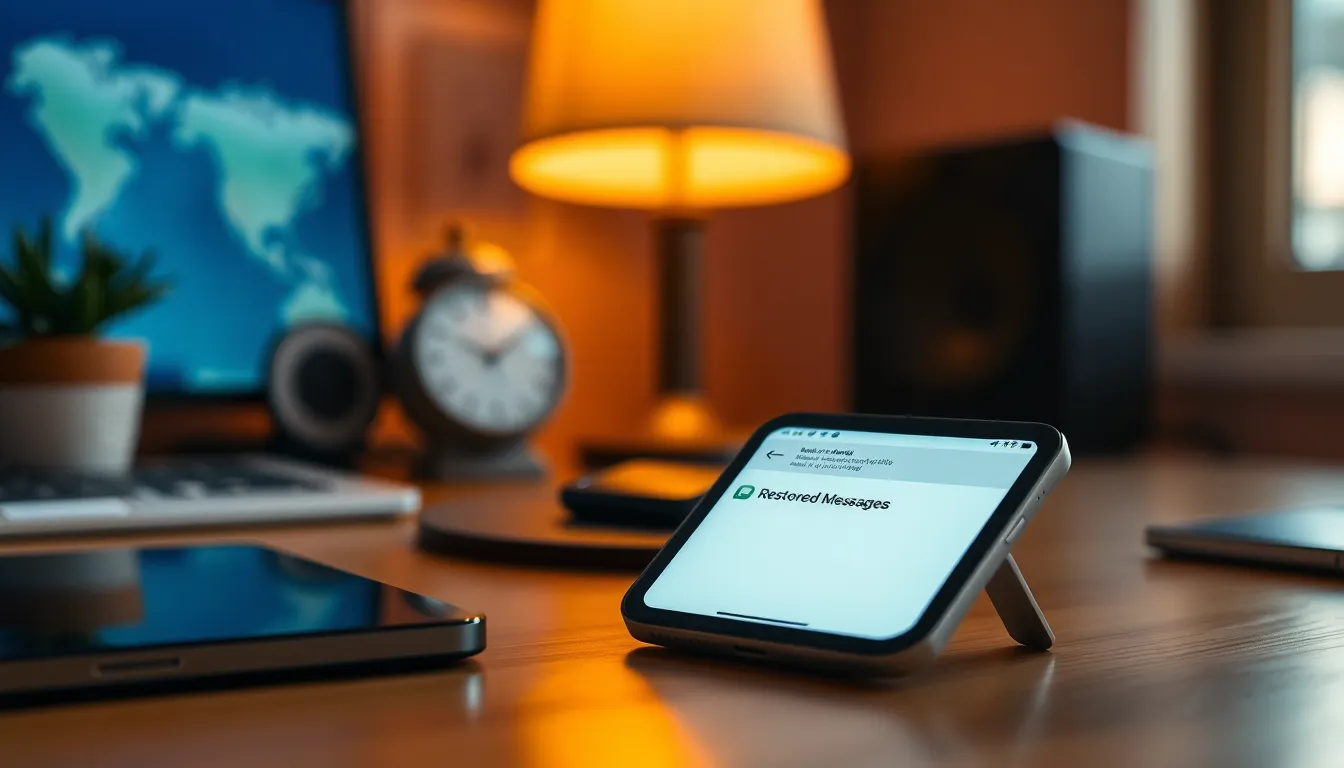Ever accidentally deleted a message on your iPhone and thought, “Well, there goes my chance to solve that mystery”? You’re not alone. Many users find themselves in a digital pickle when those important texts vanish into thin air. But fear not! There are ways to retrieve those sneaky messages, and it doesn’t involve a crystal ball or a tech wizard.
Table of Contents
ToggleOverview of Restoring Deleted Messages
Restoring deleted messages on an iPhone involves several effective methods. Users can recover texts through iCloud or iTunes backups. Accessing these backups restores entire message histories, including those mistakenly deleted.
Third-party applications provide an alternative solution for those without backups. These tools scan devices for recoverable data, retrieving lost messages. Many of these applications feature user-friendly interfaces, simplifying the recovery process for individuals unfamiliar with technology.
Using iCloud, users must enable the backup feature prior to deletion. When enabled, messages sync automatically, ensuring they are stored safely. Selecting the latest backup from iCloud can restore messages deleted since then.
iTunes backups offer an additional recovery method. Users should regularly back up their phones using iTunes to maintain a recent version of all data, including messages. Selecting the appropriate backup file through iTunes also allows users to restore deleted texts.
Enabling “Messages in iCloud” ensures continuity in message storage across devices. Synced messages remain safe even when deleted from one device. Users can view messages from any synced device, reducing the chances of permanent loss.
Within the Messages app, users can also check the “Recently Deleted” folder. This feature holds deleted messages for up to 30 days before permanent deletion. Users can retrieve texts within this timeframe directly from the app.
By understanding these methods, users can tackle the challenge of retrieving deleted messages efficiently and effectively.
Methods to Retrieve Deleted Messages

Accidentally deleting messages on an iPhone can be frustrating. Several methods exist to recover these texts effectively.
Using iCloud Backup
The iCloud Backup feature offers a reliable way to restore deleted messages. Users must first ensure that iCloud is enabled and the Messages in iCloud option is activated. By going to Settings, selecting the user’s name, tapping on iCloud, and enabling Messages, users synchronize their messages across devices. To restore deleted messages, navigate to Settings, tap on General, and select Reset. Choosing “Erase All Content and Settings” initiates the process, leading to a prompt to set up the iPhone again. At this point, select the option to restore from iCloud Backup. When the relevant backup is selected, lost messages will reappear on the device.
Using iTunes Backup
iTunes Backup provides another solid option for message recovery. Those with recent iTunes backups can leverage this method effectively. First, connect the iPhone to a computer with iTunes installed. Open iTunes and select the device. Then, choose “Restore Backup” to access available backups. It’s crucial to pick a backup dated before the messages were deleted. After starting the restore process, users can expect their deleted messages to return once the operation completes.
Third-Party Applications
Various third-party applications can scan iPhones for deleted messages when no backups exist. Many of these apps provide user-friendly interfaces to facilitate recovery. After installing a selected application, follow the on-screen instructions to connect the iPhone and initiate the scan. A complete scan will identify recoverable messages and other data. Users can then choose specific messages to restore directly to the device. Ensure that any selected application is reputable to avoid potential risks to personal data.
Common Issues When Recovering Messages
Recovering deleted messages on an iPhone can come with several challenges. Users often encounter compatibility issues, especially with varying iPhone models.
Compatibility with Different iPhone Models
Different iPhone models might support unique features for message recovery. iPhones running on older iOS versions may not offer the same backup options available in the latest systems. Many third-party applications may also distinguish their compatibility based on the specific iPhone model. Users should ensure their devices meet the necessary requirements for the chosen recovery method. Verifying application support prior to installation can save time. Checking iOS updates can also improve the likelihood of successful data recovery.
Data Loss Risks
Data loss remains a significant risk when attempting to recover deleted messages. Overwriting existing data may occur if users actively use their devices after message deletion, complicating recovery efforts. Accidental overwriting happens when new messages or downloads replace old data in storage. Reliability varies among third-party software options, and some might fail to recover messages adequately. Missteps during recovery attempts can lead to further complications. Users benefit from making regular backups to mitigate future risks and retain access to important messages.
Tips for Preventing Future Message Loss
Regularly backing up messages ensures that important texts remain accessible. Users should enable iCloud Backup on their iPhone to automatically save messages and other data. Setting this feature up requires navigating to Settings, tapping on the user’s name, selecting iCloud, and turning on iCloud Backup.
Utilizing iTunes for periodic backups provides an additional layer of security. Connecting an iPhone to a computer and routinely syncing will preserve essential messages.
Activating the “Messages in iCloud” feature syncs messages across all devices. By doing so, deleted messages can be recovered easily from any device logged into the same Apple ID.
Checking the “Recently Deleted” folder within the Messages app allows for quick retrieval of texts deleted within the last 30 days. Recovering from there is straightforward and often the first step users should take.
Maintaining device storage in optimal condition reduces the risk of unintentional deletions. Regularly deleting unnecessary apps or files frees up space and limits the chances of messages getting lost.
Staying updated on the latest iOS version benefits overall performance and stability. Compatibility issues with backup options sometimes arise with outdated systems.
Lastly, being cautious during device usage can prevent accidental deletions. Avoiding unintentional swipes or taps especially during critical moments preserves message safety.
By implementing these practices, users can significantly reduce the risk of losing important messages on their iPhones.
Recovering deleted messages on an iPhone is entirely possible with the right methods. Users can take advantage of iCloud and iTunes backups or explore third-party applications for effective recovery. Regularly backing up important messages is essential for preventing future loss and ensuring peace of mind. By activating features like “Messages in iCloud” and utilizing the “Recently Deleted” folder, users can streamline the recovery process. Maintaining device storage and staying updated on iOS can further minimize accidental deletions. With these strategies in place, users can protect their valuable messages and navigate the digital landscape with confidence.









